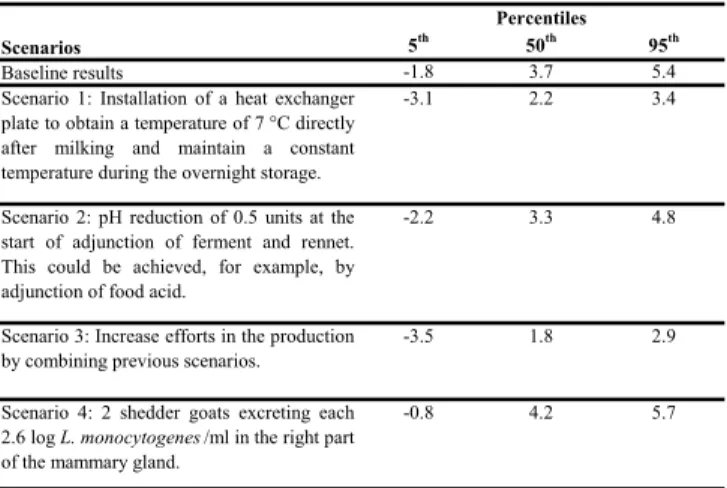Introduction
A retrospective study was made to assess the risk of listeriosis following a c o n t a m i n a t i o n b y L i s t e r i a
monocytogenes of cheeses made from
goat raw milk reported by the Belgian Federal Agency for the Safety of the Food Chain in 2005. On basis of the collected data, a quantitative risk assessment model was developed covering the production chain from the milking of goats until the consumed products.
Development of a quantitative risk assessment model for cheese
made from raw goat milk contaminated by Listeria monocytogenes
Materials and methods
The principles of the Modular Process Risk Model (MPRM) methodology were used to break down the food production chain into modules and to follow the bacteriological concentration of the pathogen throughout the process (Figure 1). Each module generates an output that is used as an input for the next module. The simulated events are identified for each module: growth, mixing and/or partitioning. Input values are classified as process inputs, microbiological or food characteristics. Predictive microbiology models were used in the exposure assessment step to simulate the growth of L. monocytogenes during the cheese manufacturing process in relation to dynamic environmental conditions including changes in temperature, pH and water activity.
Results and discussion
The table 1 gives the results of the modular exposure assessment model and shows a significant growth of L.
monocytogenes during chilling and storage of the milk
collected the day before the cheese production (increase of 0.6 log cfu / ml) and during adjunction of starter and rennet to milk (increase of 0.8 log cfu / ml). The estimated final result (P50) in the fresh cheese is equal to 3.3 log cfu/g. The model was validated by comparison of the final result issued from the exposure assessment with the number of L.
monocytogenes analyzed in the fresh cheese (3.6 log cfu / g)
reported in the listeriosis episode. The average number of expected cases of listeriosis was 1 for a high-risk sub-population. Scenarios analysis were finally performed to identify the most significant factors and aid in developing priorities for risk mitigation (table 2). The Installation of a heat exchanger could be a good opportunity to reduce the final contamination.
Delhalle L
.a*, Ellouze M.
b; Clinquart A.
a, Daube G.
a, Yde M.
cand Korsak N.
a a University of Liege, Food Science Department, Sart-Tilman, B43bis, 4000 Liege, Belgiumb IFIP, 7, Avenue du Général de Gaulle, 94 704 Maisons Alfort, France.
c Scientific Institute of Public Health, Bacteriology section, Rue Juliette Wytsmanstraat 14 - 1050 Brussels, Belgium.
5th 50th 95th
Milking
Concentration in a tank before storage
over night of the evening milk -5 0 0.47 log cfu/ml
Storage of the evening milk
Concentration in the tank after storage
over night of the evening milk -3.3 2 2.8 log cfu/ml
Adjunction of ferment and
Concentration before draining off the
curdles -2.1 3.3 4.8 log cfu/ml
Draining off the curds
Number of L. monocytogenes per
cheese 0.2 5.7 7.4 log cfu/cheese
Concentration of L. monocytogenes in
a serving of cheese -1.8 3.7 5.4 log cfu/g
Number of L. monocytogenes per
serving of cheese -0.1 5.4 7.1 log cfu/serving
Risk of human listeriosis (normal
population) 0 0 0
Risk of human listeriosis (susceptible
population) 0 0 2.10-5
Total number of human listeriosis 0 0 1 people
Unit Cooled storage and wrapping Human effect Modules Item Percentiles
Table 1: Baseline results of the exposure assessment and the risk characterization modules
5th 50th 95th
Baseline results -1.8 3.7 5.4
Scenario 1: Installation of a heat exchanger plate to obtain a temperature of 7 °C directly after milking and maintain a constant temperature during the overnight storage.
-3.1 2.2 3.4
Scenario 2: pH reduction of 0.5 units at the start of adjunction of ferment and rennet. This could be achieved, for example, by adjunction of food acid.
-2.2 3.3 4.8
Scenario 3: Increase efforts in the production by combining previous scenarios.
-3.5 1.8 2.9
Scenario 4: 2 shedder goats excreting each 2.6 log L. monocytogenes /ml in the right part of the mammary gland.
-0.8 4.2 5.7
Scenarios
Percentiles
Table 2: Results of the scenarios analysis (Concentration of
L. monocytogenes in a cheese (log cfu/g))
Conclusions
The process does not prevent the contamination by
Listeria monocytogenes
The model seems to correctly estimate the fate of Lm Surveillance in the primary sector difficult but may be improved
No reported human listeriosis connect to this contamination
Risk analysis can be useful in a HACCP process
